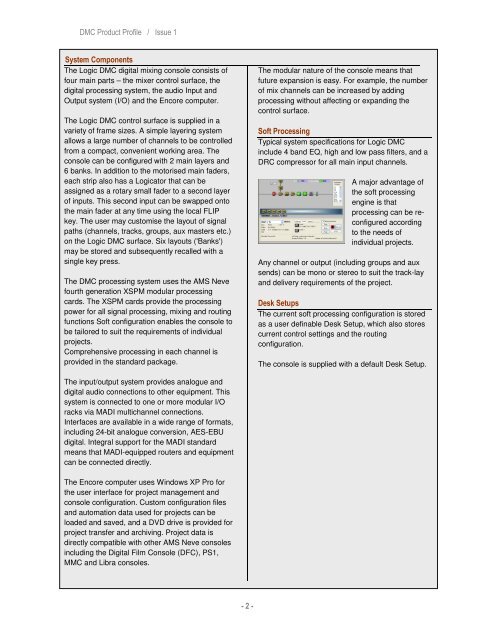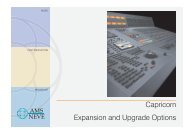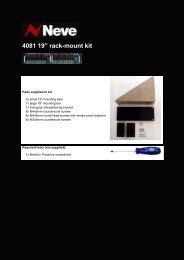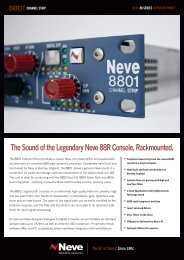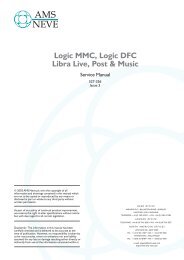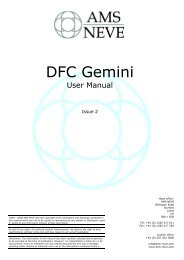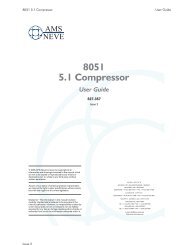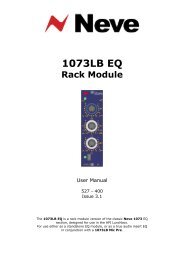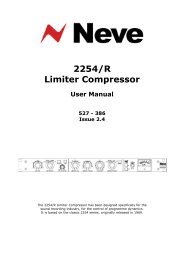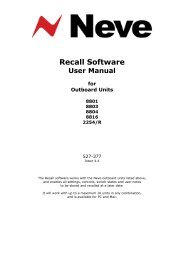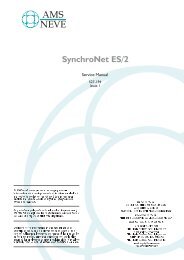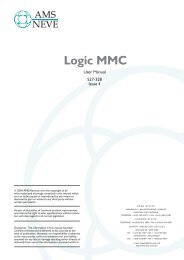DMC Product Profile - AMS Neve
DMC Product Profile - AMS Neve
DMC Product Profile - AMS Neve
You also want an ePaper? Increase the reach of your titles
YUMPU automatically turns print PDFs into web optimized ePapers that Google loves.
<strong>DMC</strong> <strong>Product</strong> <strong>Profile</strong> / Issue 1<br />
System Components<br />
The Logic <strong>DMC</strong> digital mixing console consists of<br />
four main parts – the mixer control surface, the<br />
digital processing system, the audio Input and<br />
Output system (I/O) and the Encore computer.<br />
The Logic <strong>DMC</strong> control surface is supplied in a<br />
variety of frame sizes. A simple layering system<br />
allows a large number of channels to be controlled<br />
from a compact, convenient working area. The<br />
console can be configured with 2 main layers and<br />
6 banks. In addition to the motorised main faders,<br />
each strip also has a Logicator that can be<br />
assigned as a rotary small fader to a second layer<br />
of inputs. This second input can be swapped onto<br />
the main fader at any time using the local FLIP<br />
key. The user may customise the layout of signal<br />
paths (channels, tracks, groups, aux masters etc.)<br />
on the Logic <strong>DMC</strong> surface. Six layouts ('Banks')<br />
may be stored and subsequently recalled with a<br />
single key press.<br />
The <strong>DMC</strong> processing system uses the <strong>AMS</strong> <strong>Neve</strong><br />
fourth generation XSPM modular processing<br />
cards. The XSPM cards provide the processing<br />
power for all signal processing, mixing and routing<br />
functions Soft configuration enables the console to<br />
be tailored to suit the requirements of individual<br />
projects.<br />
Comprehensive processing in each channel is<br />
provided in the standard package.<br />
The modular nature of the console means that<br />
future expansion is easy. For example, the number<br />
of mix channels can be increased by adding<br />
processing without affecting or expanding the<br />
control surface.<br />
Soft Processing<br />
Typical system specifications for Logic <strong>DMC</strong><br />
include 4 band EQ, high and low pass filters, and a<br />
DRC compressor for all main input channels.<br />
A major advantage of<br />
the soft processing<br />
engine is that<br />
processing can be reconfigured<br />
according<br />
to the needs of<br />
individual projects.<br />
Any channel or output (including groups and aux<br />
sends) can be mono or stereo to suit the track-lay<br />
and delivery requirements of the project.<br />
Desk Setups<br />
The current soft processing configuration is stored<br />
as a user definable Desk Setup, which also stores<br />
current control settings and the routing<br />
configuration.<br />
The console is supplied with a default Desk Setup.<br />
The input/output system provides analogue and<br />
digital audio connections to other equipment. This<br />
system is connected to one or more modular I/O<br />
racks via MADI multichannel connections.<br />
Interfaces are available in a wide range of formats,<br />
including 24-bit analogue conversion, AES-EBU<br />
digital. Integral support for the MADI standard<br />
means that MADI-equipped routers and equipment<br />
can be connected directly.<br />
The Encore computer uses Windows XP Pro for<br />
the user interface for project management and<br />
console configuration. Custom configuration files<br />
and automation data used for projects can be<br />
loaded and saved, and a DVD drive is provided for<br />
project transfer and archiving. Project data is<br />
directly compatible with other <strong>AMS</strong> <strong>Neve</strong> consoles<br />
including the Digital Film Console (DFC), PS1,<br />
MMC and Libra consoles.<br />
- 2 -


